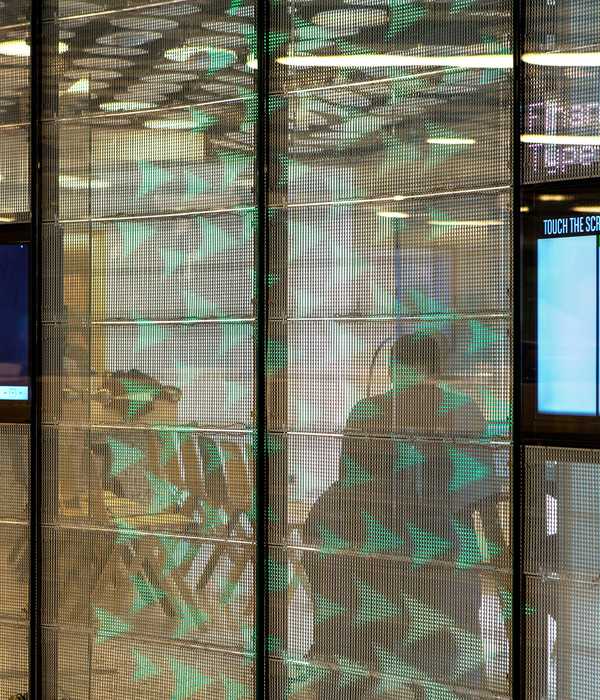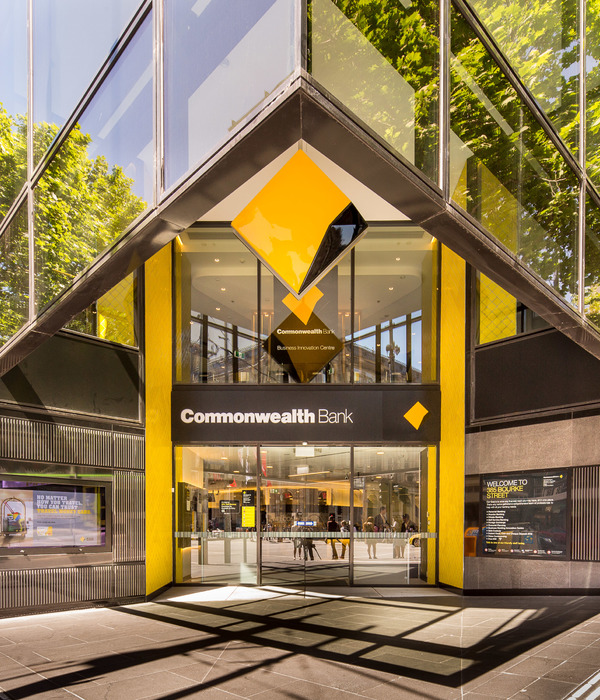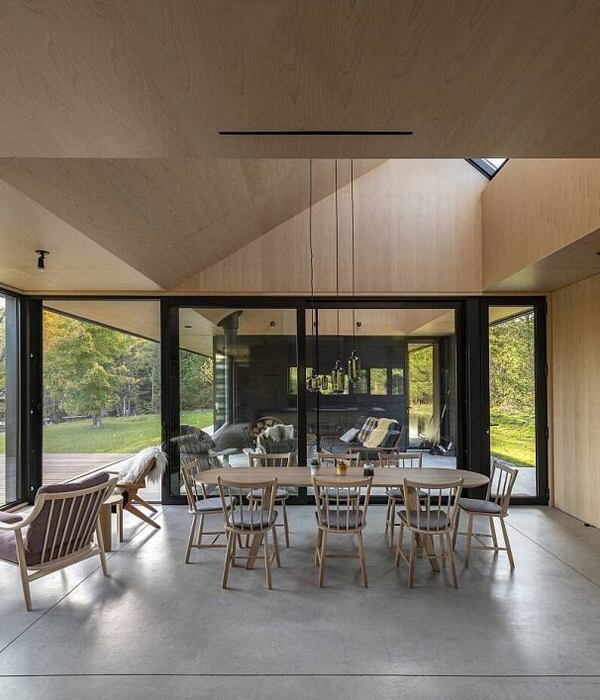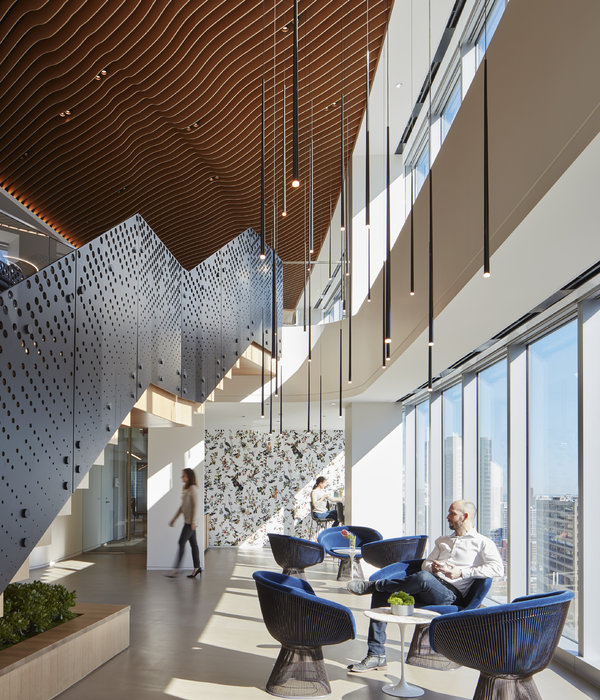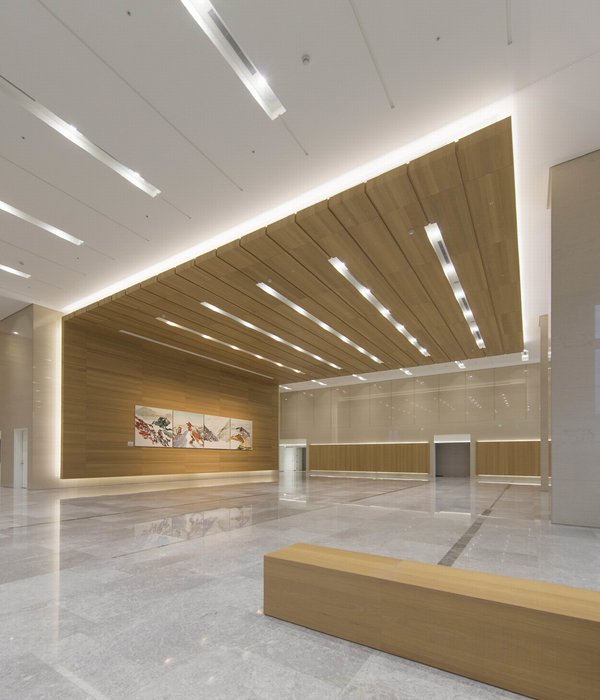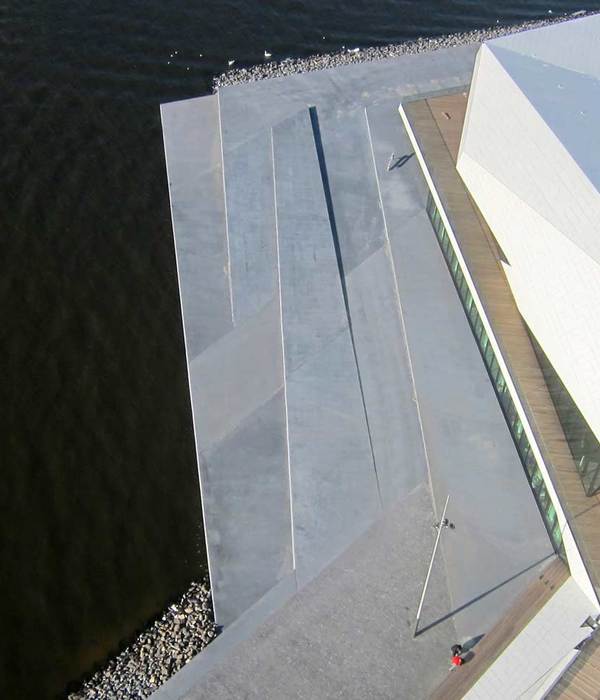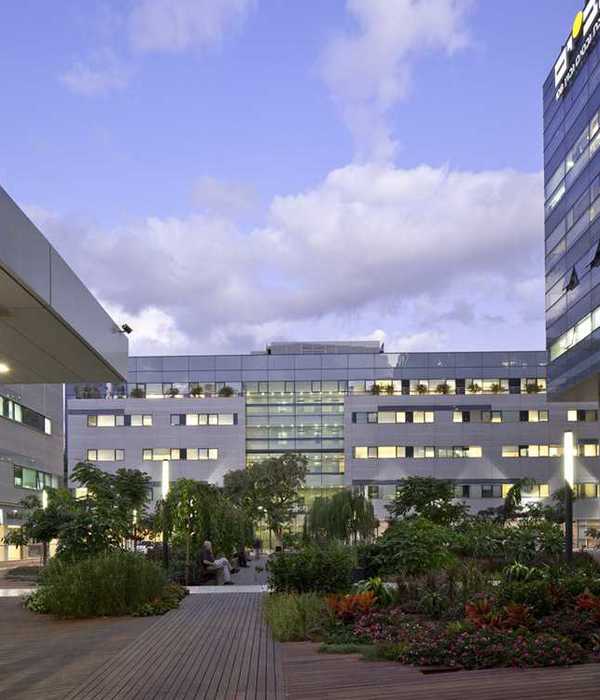林地雨水花园 | 自然与设计的完美融合
“The project features such an elegant use of native plants. There is balance here between design and nature. It’s more about site and
horticulture. It’s very subtle and beautifully done.”
– 2014 Awards Jury
“这个项目的特点在于对本土植物的完美应用。在设计和自然之间保持一种平衡。这更多关乎选址和园艺学。非常精妙和漂亮。”
– 2014 Awards Jury2014奖项评委会
Woodland Rain Gardens by
Jeffrey Carbo Landscape Architects
,更多请至:
VIA:
ASLA
森林的保护和发展,天然材料的使用,以及创新可视的雨水收集系统,通过可视的雨水采集策略来定义和系统化这些花园。由始至终的紧密合作过程使我们公司和建筑师的工作同时进行,并针对所有的花园规划、设计和建造进行了有效意见的对话。
Preservation and enhancement of this site’s forest, and the use of native materials, with innovative and visible rain water collection systems, define and organize these gardens, by highlighting water collection strategies. An intensely collaborative process from inception allowed our firm and project architect to work simultaneously, allowing a dialogue through planning, design resolution and construction of all site and garden elements.
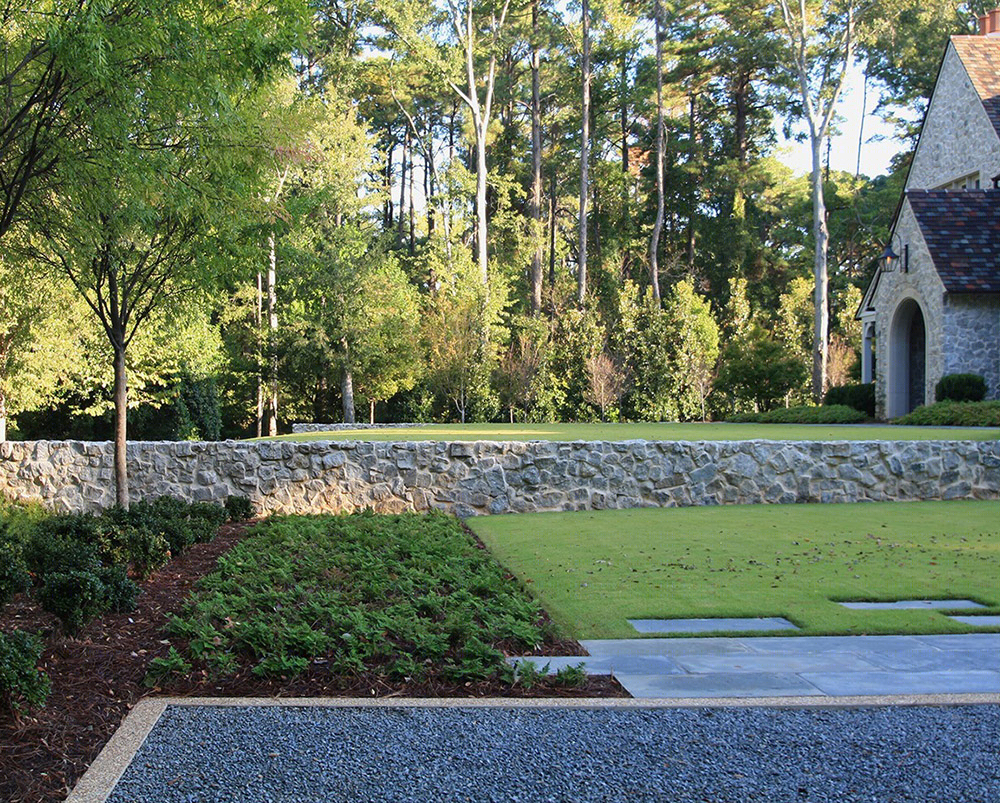
▲地面铺装为花岗岩与石灰石碎石。石砌矮墙背后的台地远处是松林和阔叶林。
Simple curbing contains permeable and loose limestone within the drive and auto court. Stone walls contain terraced lawns for flexible use. Low horizontal walls are intended to frame the verticals of the pine and hardwood forest beyond.Photo Credit: Rebecca A. O’Neal Jeffrey Carbo Landscape Architects
在西北路易斯安那州的这个住宅占据了5英亩的土地。这片区域的山坡上有着繁茂的松树和本土的硬木植被。一条在西部边缘位置的南北走向的山沟,是大约周围100英亩森林的排水走廊。山沟的水位在暴雨后最多能高出水平面8-10英尺。一条由红河谷附近以前的路线形成的陡峭的悬崖河,有着茂密的硬木树冠植被,这组成了东边界的大部分区域。
客户是当地土生土长的人,在回到家乡开始这个项目之前在英格兰的科茨沃尔德地区定居了20多年。我们公司与顾客和建筑师合作了2年时间去准备这个区域的总体规划和施工文件。我们公司开始提出了居住区位置的发展性的建议的计划,最终推荐的位置在东部边界附近的山脊和悬崖附近。这里的松树林和森林景观能给客户一览无余的视野。我们还对大门入口、车道以及住宅旁包括道路、墙壁、走廊、停车区和雨水收集系统等在内的花园区域进行了规划。
车道是两边突起呈曲线形的石状结构,车道比山沟的最高水位线略高,这样的设计避免雨水季节期间受到受雨水影响。这个区域的大多数森林都得到了保护,并且斜坡边的林中落叶层和可见的防治区的边缘地区,驾驶者感兴趣的视野上还另外种植了很多其他的树木,像本地的蕨类植物,灌木。同时,车道旁还有许多可以漫步的蜿蜒小道。
草坡作为为客户子孙提供活动与玩耍的区域外,还为居民构成了花园房外的风景。让人们在观赏透过远处密密层层的树冠和森林拥有一片更加开阔的视野。客户还要求,根据科茨沃尔德区域里的石头村舍和矮墙的启发,进行建筑上的设计。由于受到当地材料的限制,我们对此与委员会方面进行了激烈的讨论。但当我们的提议——使用石灰岩石材(因为当地许多河岸边缘都用这种石材加固)得到肯定,我们如释重负。这让整个工程更加结合当地实情。
从项目之初到维护,我们根据客户的规划和偏好,保证森林、山涧和陡坡的完工。我们的设计目标也包括:
1】设计简单且相对小的花园房供休闲玩耍,分成林地边缘、园艺广场、雨水收集区以及森林入口几部分。
2】在居民区周围的花园区采用可见排水系统以及集水技术(即使年降雨量将达到近60-70”英寸。并且,过去三年内已经减少了超过25%英寸
的降水量。我们相信水是一种珍贵的商品,即使在这样的环境当中,这种意识也会不断增加)
3】为了保护树冠,减少场地平整和环境破坏,设计出富有特点、效果显著的登记和到达顺序,速度缓慢,展现出住宅和花园景观。
4】满足客户需求,采用一种简单又不唐突的方法设计一个场所供草药、多年生植物以及蔬菜培养种植的场所,易于维护,又不会使雨水花园
逊色。
5】巧妙的将植物分类,种植在峡谷边缘,聘用当地人控制水土,保护峡谷,使其成为一个舒适愉快的场所。
我们许多的设计决策是基于当地材料以及先例,回忆客户偏爱的的国外景观风格,并进行协调。我们强调采用低水平线以及景观特征,放大强有力的森林景观,使其作为主导。
许多设计面主要是围绕我们不能做什么而不是我们做的……不断地将设计想法进行编辑、融入到设计当中,使自然美与小的设计要素相对。在我看来,这是引人注目的。花园设计其实就是那么简单。
后方的雨水花园直接根据客户的要求建造草坪及其他……“从卧室的窗户向外就能看见森林,我们可以享受到大自然和鸟儿的歌唱。这一定很吸引人!”这座拥有桦树林、蕨类植被、鸢尾花、紫珠的
花园,在未来将引导和售卖给客户,成为借助当地资源和原生态的美的典型之作。同时从居民后面房顶上收集雨水,附近梯级草坡,都将呈现一派工作景象。
从主卧向陡坡望去,由柏木做成的木板桥将其他分隔开的区域连成一片,扩展了视野。客户认为还有一处成功之举在于车道的设计,他们经常告诉我们,他们对驾驶的兴趣不亚于对房屋和花园的兴趣。先前的会议上,我们向客户阐述了在这里驾驶是如何有趣的体验。他们也告知了他们对项目进程起初的疑惑。不过从完成的工作上看,他们认为已经验证了我们最初的设想。

▲ 微妙的低调入口。穿过安装在低矮石墙上的铜门,越过晒着暖阳的草丛,到达蕨类植物生机勃勃的树荫下。
Low walls of limestone rip-rap mark the entry with gates constructed of metal and copper. Masses of grasses fill sunny areas and transition to ferns and under stories in shady areas. Our intent was for the entry to be visible, yet subtle.
Photo Credit: Rebecca A. O’Neal
Jeffrey Carbo Landscape Architects
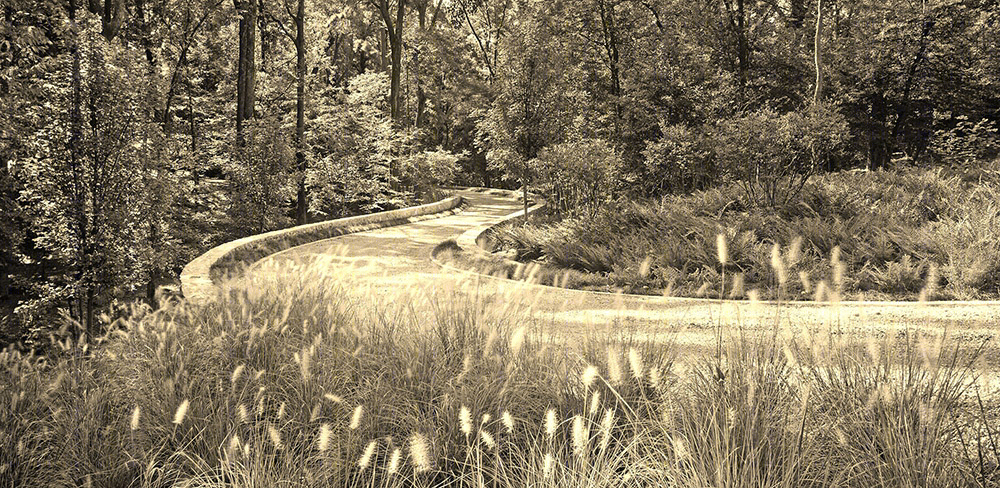
▲蜿蜒在林间的道路。修建时最大限度的保留了场地树木。
The curvilinear drive is intended to be functional, and artful, while providing uninterrupted access over the ravine, where water levels can rise as much as 8’ in intense rains. Adjacent trees were preserved by minimizing site grading.
Photo Credit: Chipper Hatter Architectural Photography
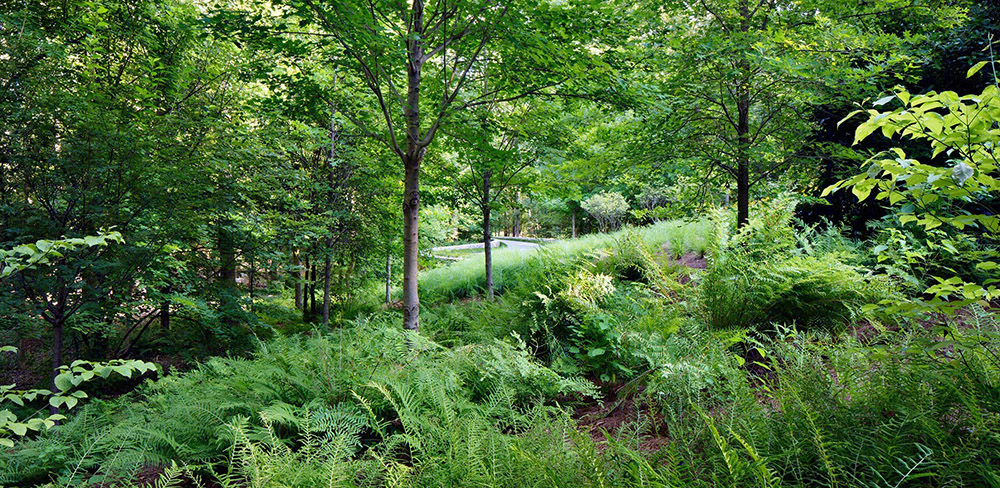
▲林下灌木与蕨类植物固定水土,稳定斜坡。
Many varieties of native ferns, understory trees and shrubs were added along the drive and within the forest to stabilize eroding slopes.
Photo Credit: Chipper Hatter Architectural Photography
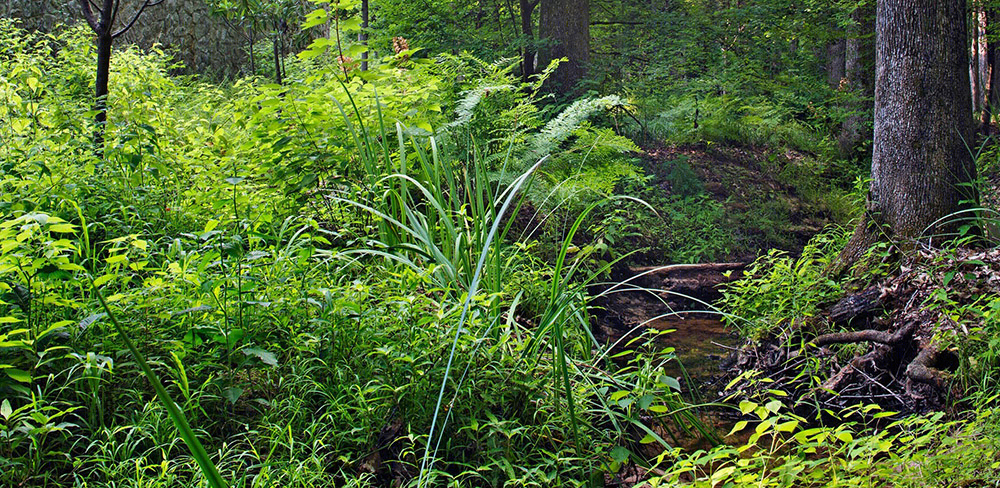
▲陡峭的山坡被精心布置的植物覆盖,土地不再被冲刷流失。山涧沟壑依稀可见,自然趣味无限。
Steep slopes along the ravine were subtlety regraded and planted continuously through the forest with natives to stabilize erosion during high water events. The ravine became an enhanced natural feature visible from adjacent walking paths.
Photo Credit: Chipper Hatter Architectural Photography
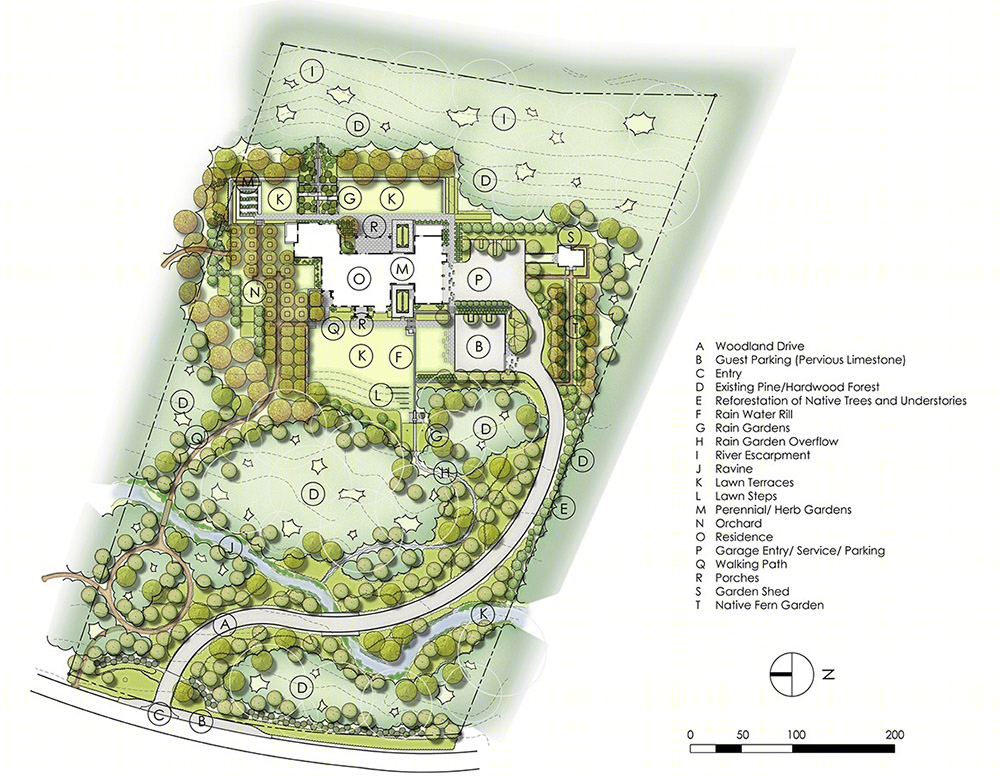
▲项目位于生路易斯安那州一处5英亩的松林阔叶林混交林地中。其中布置了建筑,停车场,草坪,花园房,雨水花园。
The residence is set within approximately five acres of preserved pine and hardwood forests with interesting topography in rural northwest Louisiana. The plan depicts the drive, guest and service parking, small lawn terraces , garden rooms and the rain gardens.
Photo Credit: Jeffrey Carbo Landscape Architects
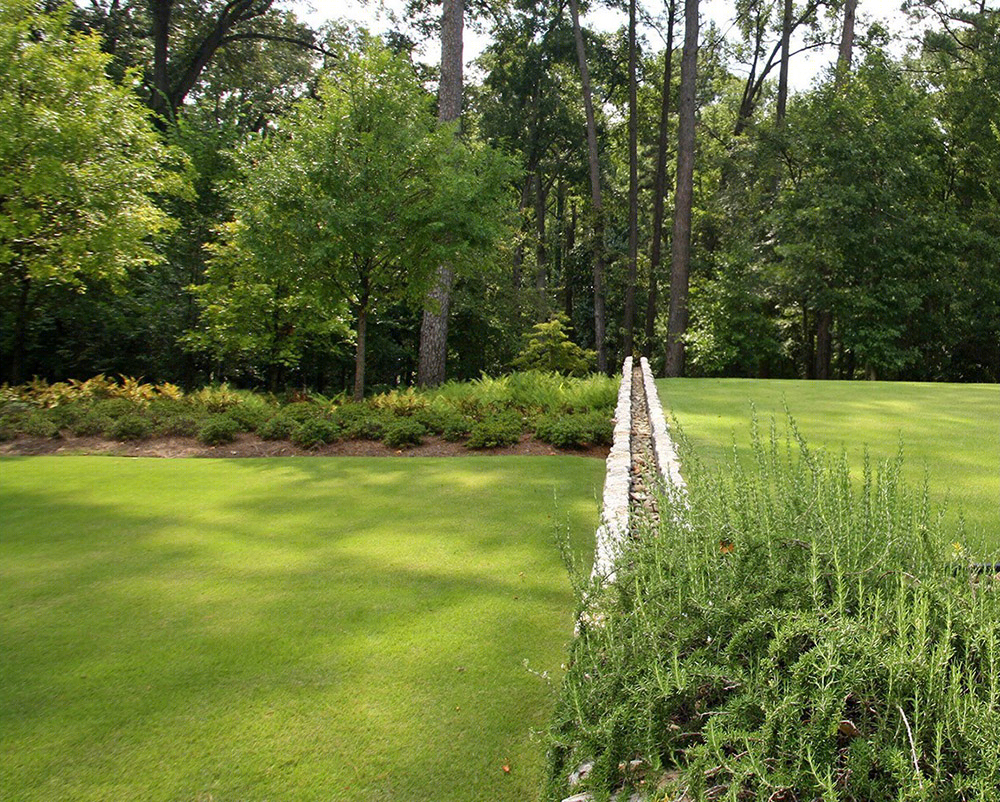
▲石材挡土墙的顶部是与屋顶相连的雨水排水沟。水流最终跌落入香草园中。优雅传统而富有想象力的优美水处理方式。
Roof drains from the residence and french drains in the lawn terrace are exposed in the top of the stone retaining walls. Rain water moves within a native rock filled stainless steel rill near a small herb garden. Our clients expressed an interest in water elements, yet challenged us to be imaginative, as they were concerned with the potential maintenance of traditional water features.
Photo Credit: Rebecca A. O’Neal
Jeffrey Carbo Landscape Architects
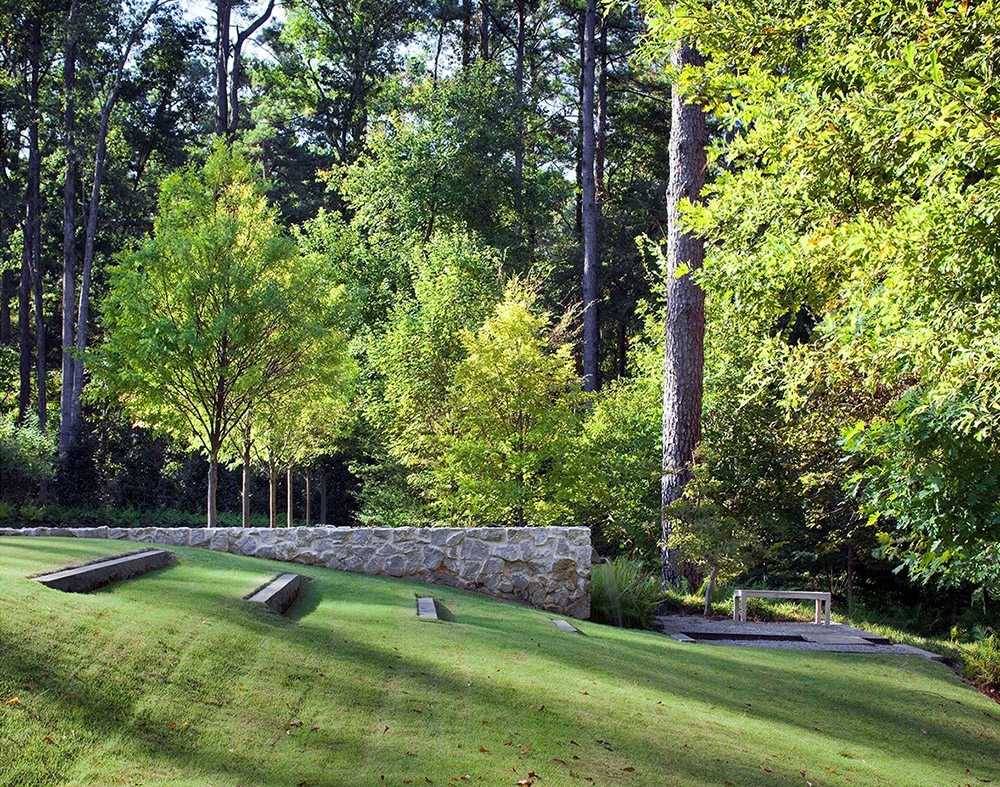
▲水流跌落到草坪低处的雨水花园休息区中。
Lawn terraces gradually transition to a small seating area near the rill outfall and rain garden, exposing the retaining wall and landscape.
Photo Credit: Chipper Hatter Architectural Photography
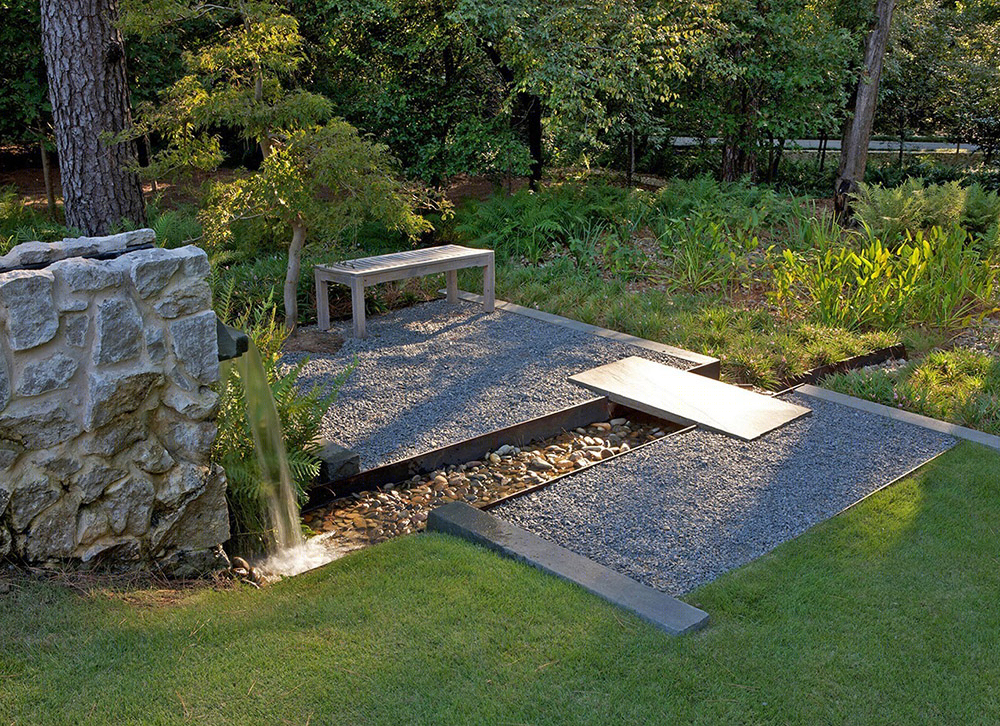
▲跌落的谁聚集在此,灌溉着沼泽花园。暴雨时,多余的水将溢出,流入下方山沟。
Rain water spills over a ledge and into a rock trough, ultimately filling a geometric bog planted with native aquatics. In dry seasons, an automatic fill is activated and creates a similar effect. During intense rains, the bog overflows into a curvilinear rock rill, and ultimately to the ravine below.
Photo Credit: Ralph Lee Anderson

▲穿过草坪上的原生树林,通过后花园的碎石道路。
A grove of native fringe trees frame a loose aggregate path leading to the rear area gardens.
Photo Credit: Ralph Lee Anderson
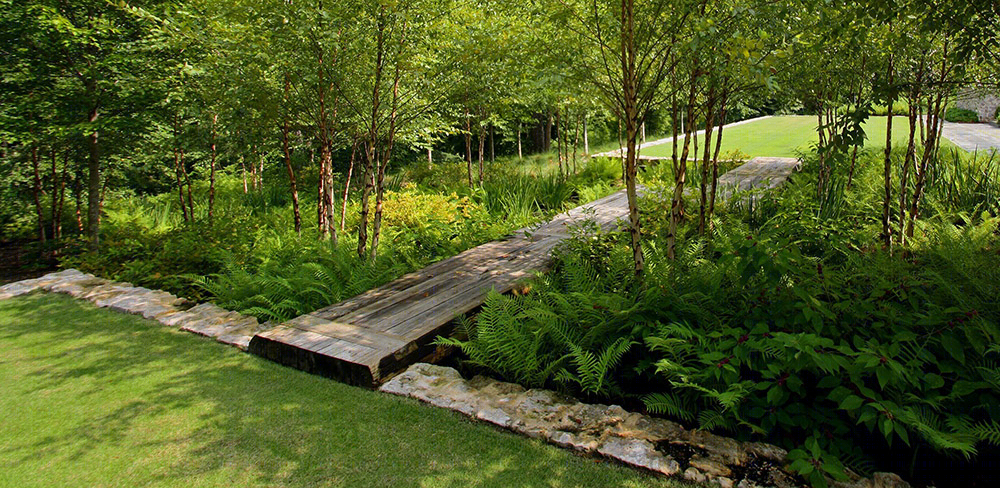
▲ 地势较低的雨水花园处于后花园的树林中,这里有茂密的桦树,柳树,蕨类植物。桥对面的平台直接与主卧套房联系。
Rear garden terraces are framed by forest and lower rain gardens, filled with native birch, willow, fern and iris. Roof drains on the residence and french drains in the lawn terrace fill the space defined by low stone walls. Cypress logs were harvested from nearby river bottoms and milled to create the bridge that connects the terraces. The rain garden extends from forest edge to a large window in the master suite of residence.
Photo Credit: Rebecca A. O’Neal
Jeffrey Carbo Landscape Architects

▲桥下的雨水沟壑通往森林深处。从主卧套房就能看到该线性式景观与美丽东方日出之景。
The trough collects overflow and moves towards a rock and metal channel within the rain garden, and toward the forests and escarpment. This linear view occurs at the large windows in the master suite, and was our response to a specific client request, that directs views from an expanse of windows to sunrises in the east.
Photo Credit: Rebecca A. O’Neal
Jeffrey Carbo Landscape Architects

▲石板间生长着茂密的草,这种透水式铺装将自然领域更加扩大化。
Stone slabs with grass gaps extend the porch area into the landscape and facilitate water percolation within paved areas.
Photo Credit: Gaiennie Kathryn Fine Photography

▲雨水花园的尽头,水流经由沼泽花园,以及铺满河石的不锈钢水槽后,再落入森林悬崖。
Rain water moves within the trough of perforated stainless steel and river rock. Water collects and drips like water through a large strainer, diffusing flow that ultimately collects at the base of the forest escarpment and into an existing bog.
Photo Credit: Chipper Hatter Architectural Photography
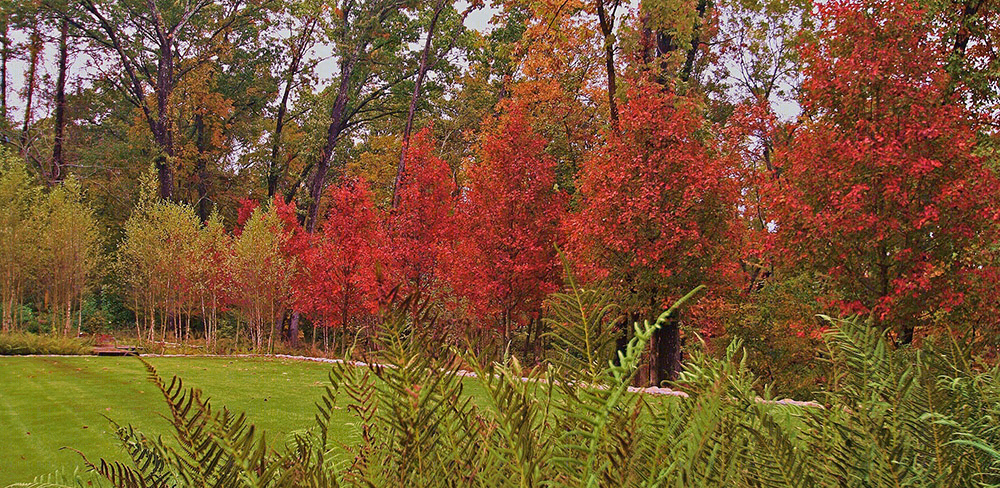
▲秋季露台边缘的红叶之趣。
Red Maples provide seasonal interest and frame the edges of the terraces.
Photo Credit: Rebecca A. O’Neal
Jeffrey Carbo Landscape Architects
This residence in northwest Louisiana occupies a five acre parcel. The site is vegetated with wooded slopes of pine and a mix of native hardwoods. A ravine, the drainage corridor for approximately 100 acres of surrounding forest, runs north /south on the site’s western edge.
Water levels in the ravine can rise as much as 8-10’ feet above normal levels after intense rains. A steep river escarpment, formed by the former route of the nearby Red River, vegetated with a dense hardwood canopy, comprises a large area on the site’s eastern boundary.
Our clients, natives of this area, resided seasonally in England’s Cotswold region for over 20 years, before returning home and beginning this project. Our firm collaborated with the clients and architect for two years preparing the site master plan and construction documents. Our firm began planning by developing proposals for the location of the residence, ultimately recommending placement on a ridge near the site’s eastern boundary and near the river escarpment. This allowed filtered views of the residence through the pine and hardwood forest. We also developed schemes for the gated entry, drive access, as well as garden spaces adjacent to the residence, including walks, walls, terraces, parking/service areas and rain water collection systems as garden features.
The entry drive is an elevated, curvilinear stone structure suspended above potential high water levels, so as to not impede flow in the ravine during rain events. Most of the site’s existing forests were preserved, and supplemented with generous plantings of native ferns, shrubs and understories along slopes and visible edges for erosion control and interest from drive views. A walking path also meanders much of the site.
Lawn terraces as flexible play areas for the client’s grandchildren also help organize the garden rooms immediate to the residence, and give spatial clarity to the heavily tree canopied drive and forests. Architectural and site details were inspired by the stone cottages and low walls of the Cotswolds region, a request of our clients. We admittedly struggled with this aspect of the commission, as this was not consistent with a local materials vocabulary. However, we became more comfortable once our suggestion to use limestone rip-rap for the stone, as many
river edges throughout this region are stabilized by using this material. It made this application seem more local.
It was our desire from the project’s inception to preserve, and engage the forests, ravine, and escarpment with the clients program and preferences. Our design goals also included:
1| Create simple and relatively small and level garden rooms for play, defined by woodland edges, gardening venues, rainwater collection, and portals into forests.2| Showcase and make visible drainage systems and rainwater harvesting techniques for garden spaces surrounding the residence, (even though annual rainfall typically is approximately 60-70” inches, it has decreased by more than 25% over the last three years. It is our belief that the perception of water as a valuable commodity will increase, even in this environment.3| Choreograph an interesting and memorable entry and arrival sequence with an elevated drive to minimize site grading and disturbance in order to preserve tree canopies, all while slowly and ultimately revealing the residence and gardens upon approach.4| Accommodate client requested venues for herbs, perennials, and vegetables in an unobtrusive and simple way that were accessible and
easy to maintain, while not detracting from the proposed rain gardens.5| Subtlety regrade and vegetate ravine edges with natives to control erosion and preserve the ravine as a site amenity.
Many of our design decisions were guided by adapting native materials and precedents to recall and reconcile the client’s preference for a foreign landscape. We emphasized the use of low horizontal lines for hardscape and landscape features to allow the powerful vertical character of the forest to be amplified and dominant.
Many design aspects became as much about what we elected not to do, than we did, ……….. Constantly editing and distilling our ideas to the essentials, allowing the beauty of nature against minimal built components, in our opinion, would be compelling. The garden design is intentionally simple.
The rear rain garden became directed by the clients request for lawn, yet another request….. “bring the forest up to our bedroom window,so we can enjoy the wildlife and birds that it might attract”! This sunken garden with birch, ferns, iris, and beautyberry became the defining gesture, further educating and selling the client on the beauty and virtues of natives, while also being a working landscape that collected rain water from the residence’s rear roofs and the adjacent lawn terraces. This feature also directed views to sunrises in the east.
The plank bridge, of milled cypress logs, connected otherwise disconnected spaces and extended linear views from the master bedroom toward the escarpment. The clients deemed this an immediate success, as they did the drive entry, and have often told us they enjoy the drive as much as the house and garden spaces, recalling early meetings where we explained how the entry drive could be a beautiful experience. They confessed their initial doubts early in the process, yet the completed work, in their opinion, validated our early descriptions.


